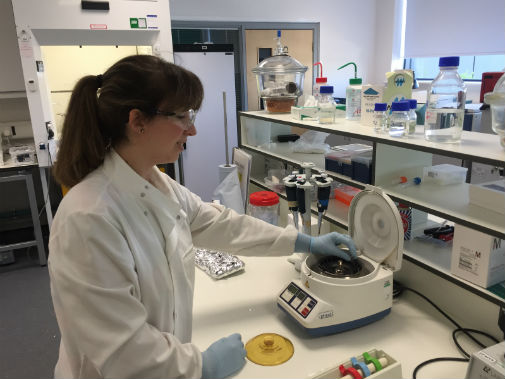Sussex Declaration: Researchers authenticate American Independence parchment
Posted on 4 July 2018

Dr Sarah Fiddyment conducted protein analysis of the parchment
The Sussex Declaration, as it has become known, is the only other contemporary manuscript copy of the Declaration of Independence on parchment apart from the signed copy at the National Archives in Washington, D.C., known as the Matlack Declaration.
There are other printed parchment copies and other handwritten copies on paper but the Sussex Declaration, housed in the West Sussex Record Office, and the Matlack Declaration, are the only two ceremonial parchment manuscript copies.
Detailed scientific tests and analysis, carried out by conservation scientists at the University of York, Harvard University, British Library, and the Library of Congress including multi-spectral imaging, X-ray fluorescence, and protein testing.
Animal skins
Researchers at the University of York used a 'peptide mass fingerprinting' technique to help discriminate between the different species of animal used to make the parchment. Typically sheepskin was used to produce legal documents in England, but there is evidence of calfskin being used for important charters.
Dr Sarah Fiddyment, from the University's Department of Archaeology, said: "Using a non-invasive sampling technique, conservators were able to dry sample the document and send us the eraser crumbs which we analysed in our lab.
"We were able to identify the species of animal used to make the parchment, which in this case was sheepskin. Sheepskin was certainly the parchment of choice for legal documents, so this result is not unexpected.
"It is however, perhaps surprising that calfskin wasn't used, because this was considered higher quality and more prestigious. For such an important document it is interesting that was not chosen."
Date revealed
Imaging revealed a date beneath an erasure on the document. The date reads either “July 4, 178” or “July 4, 179”. It is impossible to say whether there was originally a fourth digit in the year.
Analysis of the ink shows that this lettering together with the final lettering and corrections were all written in a relatively short window of time. X-ray fluorescence analysis showed that the parchment was hung up using iron nails at some point.
The parchment was believed to have been held originally by the Third Duke of Richmond, known as the “Radical Duke” for his support of the Americans during the Revolution. The team is continuing to work on the question of when and how the parchment came to be in the UK.
Wendy Walker, West Sussex County Archivist, said: “It is a fascinating document and it has been fantastic for us to work with colleagues at Harvard, the Library of Congress, the British Library and the University of York to find out more about the story that surrounds it.”
Explore more news

New butterfly species created 200,000 years ago by two species interbreeding
Thursday 18 April 2024

Children in the North at greater risk of entering care
Wednesday 17 April 2024

Boreal forest and tundra regions worst hit over next 500 years of climate change, study shows
Monday 8 April 2024

Researchers developing ultra-sensitive blood test with potential to revolutionise diagnosis of Alzheimer’s
Thursday 4 April 2024

Attitudes to being an adult are shifting as traditional milestones become out of reach, new study finds
Wednesday 27 March 2024
Media enquiries
About this research
The findings come after collaborations between Harvard researchers and archivists, conservators and scientists at the West Sussex Record Office, British Library, Library of Congress, and the University of York.
Explore our research.
